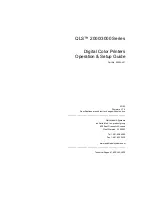
Communication Problems
174
Device Handshaking
Handshaking is the exchange of signals between the host computer and the printer to indicate the status of the data being
transferred. In serial data transfer, the printer uses both hardware and software handshaking and transmits both forms
simultaneously when the input buffer is full.
The printer can be used with either serial or parallel host interfaces. Parallel interfaces are usually straightforward, with no
special settings required. Serial interfaces, however, have a variety of possible communication parameter settings.
There are two methods of handshaking:
•
Hardware Handshaking
This is an electrical signal controlled by the logic state on pin 20 of the serial interface connector J2 at the back of the
printer. The signal goes high when the printer is ready to receive data. The signal goes low when the printer is in the busy
state, which indicates that the input buffer is full and can no longer receive data.
•
Software Handshaking
XON and XOFF
are software signals that control serial data flow between the printer and the host system. When the printer
input buffer is full, the printer transmits the XOFF (CTRL S) character, which signals the host to stop sending data. When
space becomes available in the input buffer, the printer sends the XON (CTRL Q) character, which tells the host that the
printer is ready to receive more data.
The Printer Interface
The printer will not function properly if an incorrectly wired interface cable or the wrong interface cable is installed.
Cannot access the printer through
PMU over an Ethernet Interface
(continued from previous page)
ethernet
12. Press
STOP
to exit the menu and put the printer in the NOT
READY state.
13. Power off the printer, wait a few seconds, then power on the
printer to activate the new diagnostic port. The PMU will now
establish a connection with the Ethernet Interface.
Host cannot communicate with
6500 printer when hooked up to
TCP/IP to AS/400 with the Ethernet
NIC installed
ethernet
Refer to the appropriate Ethernet Interface User’s Manual.
Table 4. Common Communications Problems
Problem
Interface
Common Causes
Summary of Contents for Infoprint 6500-v05
Page 282: ...282 Cable Routing Cabinet Model...
Page 283: ...283 Cable Routing Pedestal Model...
Page 285: ...285 Cable Assembly Centronics Dataproducts Adapter 14H5522...
Page 286: ...286 Cable Assembly 5V Remote Power 14H5589 To Controller Board...
Page 292: ...292 Cable Assembly Card Cage Fan PIN 1 PIN 1 14H5285...
Page 294: ...294 Cable Assembly Exhaust Fan PIN 1 PIN 1 14H5286...
Page 298: ...298 Cable Assembly MPU PIN 1 PIN 3 PIN 2 PIN 1 14H5329...
Page 300: ...300 Cable Assembly Ribbon Motor Extension 63H7464...
Page 301: ...301 Cable Assembly Shuttle Motor Drive 14H5330 To Shuttle To Controller Board...
Page 302: ...302 Frame Cable Power Stacker 10R3912...
Page 303: ...303 Logic Cable Power Stacker 10R4590...
Page 304: ...304 Power Cable Power Stacker 57P1376 P1101 P1101...
Page 305: ...305 Vertical Rail Cable Power Stacker 10R3913...
Page 306: ...306 Elevator I O Cable Power Stacker 10R4053...
Page 307: ...307 Fan Assembly Hammer Bank P107 HBF P107 HBF 14H5159...
Page 308: ...308 Magnetic Pickup MPU Assembly 57G1476 P03...
Page 309: ...309 Switch Assembly Paper Detector Standard 14H5281 Black Back Forms Kit 02N7169...
Page 310: ...310 Switch Assembly Platen Interlock P107 PLO 14H5280...
Page 530: ...530 WR Write w With w o Without XMT Transmit...
Page 531: ...531...
Page 544: ...G544 5978 00 07G544597800 Copyright IBM Corp 2005...
















































